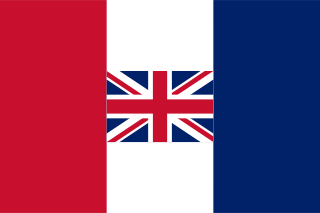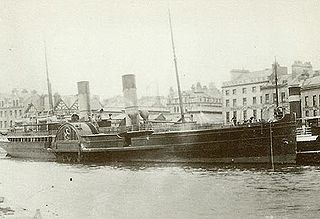
The Pacific Mail Steamship Company was founded April 18, 1848, as a joint stock company under the laws of the State of New York by a group of New York City merchants. Incorporators included William H. Aspinwall, Edwin Bartlett, Henry Chauncey, Mr. Alsop, G.G. Howland and S.S. Howland.

SS City of Glasgow of 1850 was a single-screw passenger steamship of the Inman Line, which disappeared en route from Liverpool to Philadelphia in March 1854 with 480 passengers and crew. Based on ideas pioneered by Isambard Kingdom Brunel's SS Great Britain of 1845, City of Glasgow established that Atlantic steamships could be operated profitably without government subsidy. After a refit in 1852, she was also the first Atlantic steamship to carry steerage passengers, representing a significant improvement in the conditions experienced by immigrants. In March 1854 City of Glasgow vanished at sea with no known survivors.

The Illawarra Steam Navigation Company was a shipping company that serviced the south coast of New South Wales, Australia from 1858 to the early 1950s. It was formed through the amalgamation of the General Steam Navigation Company, the Kiama Steam Navigation Company and the Shoalhaven Steam Navigation Company, each of whom serviced parts of the south coast with their respective vessels. After merging, the new company held a near monopoly in regard to shipping on the south coast, and their fleet visited every significant port between Sydney and the border of Victoria. The company transported both passengers and a range of produce, including livestock, and hence it became known as the 'Pig and Whistle Line': it was said that ships would wait an hour for a pig but not a minute for a passenger.

P Henderson & Company, also known as Paddy Henderson, was a ship owning and management company based in Glasgow, Scotland and operating to Burma. Patrick Henderson started business in Glasgow as a merchant at the age of 25 in 1834. He had three brothers. Two were merchants working for an agent in the Italian port of Leghorn; the third, George, was a sea captain with his own ship.
The Calcutta and Burmah Steam Navigation Company (C&BSN) was a British steamship company formed in 1856 and absorbed into the British-India Steam Navigation Company in 1862.
The West Cornwall Steam Ship Company was established in 1870 to operate ferry services between Penzance, Cornwall, and the Isles of Scilly. It became the West Cornwall Steamship Company in 1907 and was wound up in 1917.

TSS Maianbar was a coastal steamship of the North Coast Steam Navigation Company. Built in Scotland in 1910 she ran aground in Newcastle, New South Wales in 1940 and was later scrapped on site.
George Forrester and Company was a British marine engine and locomotive manufacturer at Vauxhall Foundry in Liverpool, established by Scottish engineer George Forrester. The company opened in 1827 as iron founders and commenced building steam locomotives in 1834.

The Scilly Isles Steam Navigation Company provided shipping services between Cornwall and the Isles of Scilly from 1858 to 1872.

SS (RMS) Tynwald (II), No. 45474, was an iron paddle-steamer which served with the Isle of Man Steam Packet Company, and was the second vessel in the Company to bear the name.

SS (RMS) Mona's Isle (I) was the first vessel ordered for service with the Isle of Man Steam Packet Company when it began its operation in 1830. No Official number is recorded for the vessel, as formal registration was not introduced until the Merchant Shipping Act 1854.
The Liverpool and North Wales Steamship Company (LNWSC) was a pleasure cruise company based in Liverpool.

SS (RMS) Queen of the Isle was a paddle steamer which was constructed by Robert Napier & Co. Glasgow. No Official number is recorded for the vessel, as formal registration was not introduced until the Merchant Shipping Act 1854.

SS Empress Queen was a steel-hulled paddle steamer, the last of her type ordered by the Isle of Man Steam Packet Company. The Admiralty chartered her in 1915 as a troop ship a role in which she saw service until she ran aground off Bembridge, Isle of Wight, England in 1916 and was subsequently abandoned.

SS (RMS) Snaefell (II) No. 67289 – the second vessel in the line's history to be so named – was an iron paddle steamer which was owned and operated by the Isle of Man Steam Packet Company.

SS (RMS) Mona (III), the third ship of the Company to bear the name, was a steel paddle-steamer which was originally owned and operated by the London, Chatham and Dover Railway Company, who then sold her to the Liverpool and Douglas Steamship Company, from whose liquidators she was acquired by the Isle of Man Steam Packet Company in 1903.

The SS Caracas (1881–1889) was a coastal passenger steamship built by William Cramp & Sons in Philadelphia. She was the older sister ship to the Valencia. Both Caracas and Valencia served from New York City to Venezuela. The short life of Caracas ended in 1889, when she ran aground in Yaquina Bay under the name Yaquina Bay.

SS (RMS) Ellan Vannin was an iron-built packet steamer which was operated out of Castletown, Isle of Man for the Castletown Steam Navigation Company to Liverpool and Whitehaven. Her name, Ellan Vannin, came from the Gaelic term by which the Isle of Man is known.

The TSS Christino Cruz was a twin screw tunnel steamship built of steel by the Lytham Shipbuilding and Engineering Co., Ltd. at Lytham, for the Companhia de Navegação a Vapor do Rio Parnahyba - CNVP, Teresina, Brazil, for whom Messrs. R. Singlehurst & Co., Liverpool, were the agents. She was intended for river service as a commercial passenger-carrying coal-fired steamship and was sailed under the Brazilian flag, having a provincial certificate of Nationality issued by the Brazilian Consul in Liverpool.

The St George Steam Packet Company – also referred to as the Liverpool and Isle of Man Steam Packet Company or the St George Steamship Company – was a privately owned maritime transportation company incorporated in 1821. In the early 1840s the business was acquired by the Cork Steamship Company.
















